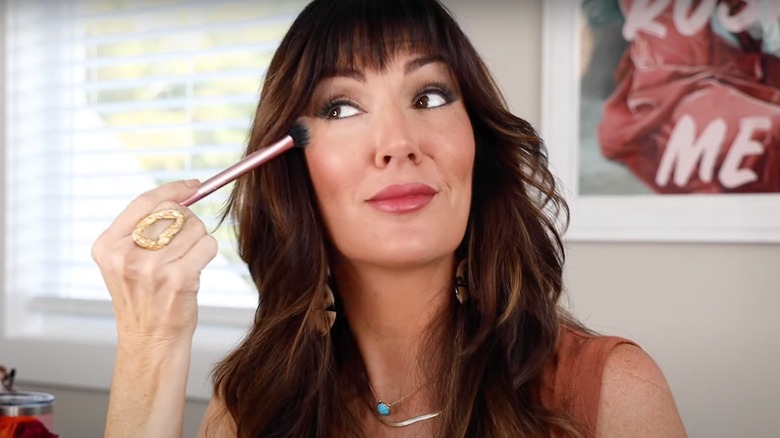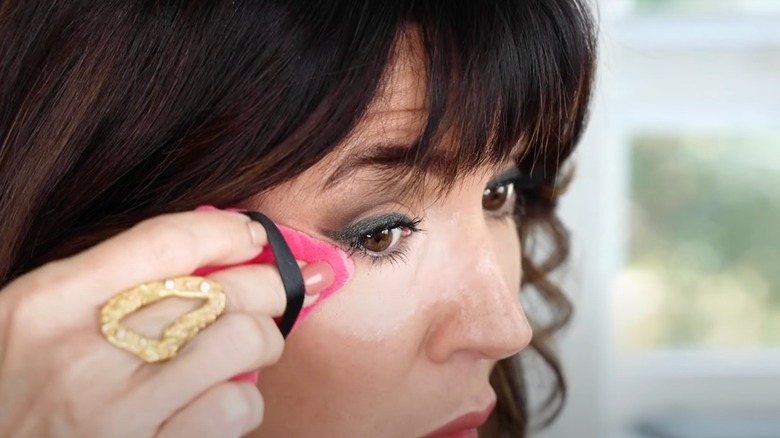Avoid One Major Mistake When Using Pink Powder On Your Under-Eyes
If you've spent any time browsing makeup trends online, you've probably noticed the pink setting powder trend. Yes, pink powder to set under-eye concealer has been rising in popularity for many reasons, including the blushy under-eye look that's popular among lovers of the coquette makeup aesthetic. But this bright pink under-eye look isn't for everyone, and if you don't want to look like you don't know where blush goes or, worse, have a weird case of under-eye pink eye, you might be staying far from pink powder.
Pink setting powder, though, isn't actually meant to leave your under-eyes looking bright pink (and it's worth noting that some pink powders on the market look fairly white despite achieving their color-correcting duties). Pink powder is much more suitable for going over regular powder to do its job — brightening and subtle color-correcting — much better than it could on its own. So, if you try this trend, avoid putting your pink powder directly on freshly blended concealer. "The difference is not setting wet concealer with ultra-pink powders," beauty brand owner and makeup lover Rose Siard explained in a popular TikTok video. Curious to understand pink powder better?
Why you shouldn't set concealer with pink powder
Now you know what to avoid: applying pink face powder directly on unset concealer. But why, exactly? Isn't that what most people are doing on social media?
While some people like the pink under-eye look for the overall flush it gives the area, they won't necessarily be able to achieve the same look with pink powder — the blushy under-eye look is better achieved with cream blush. Rather, the purpose of applying pink powder under the eyes is to brighten and even out the skin tone where concealer failed to do so. However, you shouldn't apply your pink powder directly to your wet concealer. Rose Siard explains it succinctly: Putting bright pink powder on wet concealer "would just absorb all of that pigment and make it extremely pigmented." Because of this, it's best to avoid using pink powder as your setting powder and to leave that job to your regular translucent or skin-toned powder.
Since concealer isn't enough to cover the darker green and blue hues beneath the eyes for many, and because color-correcting with cream products often seems too daunting, pink powder is the more accessible alternative that can do wonders for everyone. Just remember to apply it after your regular powder so that you don't look like you're crying cherry blossom tears. Barbiecore is trendy, but not that trendy.
How to use pink powder correctly
You know what to avoid, but the question of how to do it right remains. According to Rose Siard's video tutorial, you only need a light layer of your regular setting powder beneath the eyes and an equally light, even layer of pink powder following straight after. You can use any tools you have for this, including powder brushes, but a triangle powder puff will give you the most even and closest application, as it allows you to take it all the way into the corner of your eye. That's not all, though. "A powder puff gently locks in makeup without the tugging or streaking of a brush, giving an overall more flawless finish," makeup artist Nikki La Rose-Bonaldi told Byrdie.
And if you were wondering, different shades of pink work better for different skin tones. On this, makeup artist Jordana Ticia told Vogue India of the pink powder trend, "I would always tend to recommend a peach or yellow undertone powder for dark skin tones, simply because those tones really compliment deeper complexions. However, going over the top of an already set under eye and baking with a small amount of pink powder can work well on dark skin."

